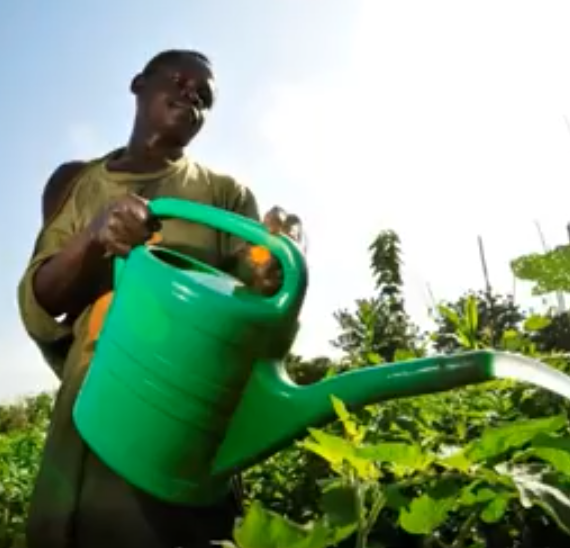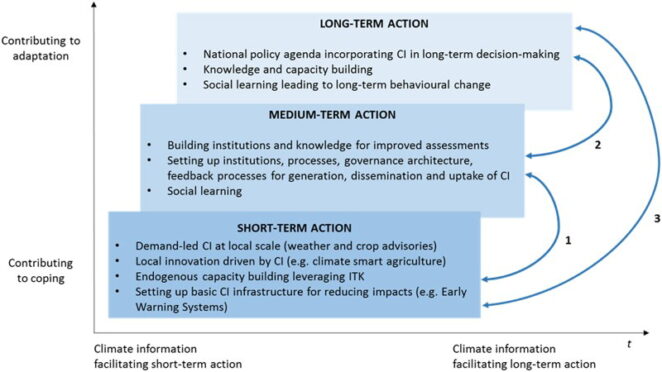The utility of weather and climate information for adaptation decision-making: current uses and future prospects in Africa and India

Introduction
Developing countries share many common challenges in addressing current and future climate risks. A key barrier to managing these risks is the limited availability of accessible, reliable and relevant weather and climate information. Despite the growing provision of climate services across Africa and India, there often remains a mismatch between available information and what is needed to support on-the-ground decision-making.
Through the literature review for the Adaptation at Scale in Semi-arid Regions (ASSAR) project, it was identified that the current provision and use of climate information is a critical barrier for adaptation at scale.
This paper therefore undertook literature reviews and expert interviews focused on 2 regions: Africa and India, to better understand available climate information, its current utility and uptake in sub-national decision making contexts and barriers to further use and uptake in these regions.
This open access paper was originally published on the 12 May 2017 in Climate and Development.
*Downloadof the full text is available from the right-hand column and via the link provided under Further Resources. A summary of the key messages is provided below. Please refer to the full text for more detail.
Climate Information
The paper outlines the differences between weather and climate information, and provides an overview of the range of globally and regionally available weather and climate information. It notes that while there is an increasing volume of climate data available through online portals, users of these portals are mostly limited to researchers and impact assessment modellers.
Externally provided weather and climate information has an important role in building on local knowledge to shape understanding of climate risks and guide decision-making across scales. The paper details examples of current information providers in Africa and India and the information and services which they provide.
Short-term vs long-term climate information
Case studies from Africa and India demonstrate that successful decision-making can be achieved with currently available information. However, these successful examples predominantly use daily, weekly and seasonal climate information for decision-making over short time horizons. Examples include a decision analysis framework to communicate seasonal climate forecasts in India and the Adaptation Learning Programme (ALP) for Africa. Further examples and their characteristics can be read in Table 1 (pp. 7-8) in the full text. Participatory approaches to designing and interpreting climate information and the tailoring of climate products and information are recognised as important for their uptake in decision making.
There are a greater number of examples of the use and uptake of short term climate information but very few clear examples of long term climate information informing decision making at sub-national scales despite an increasing volume of global and regional climate model simulations. The paper argues that this is largely because the information produced and disseminated is often ill-suited to inform decision-making at the local scale, particularly for farmers, pastoralists and sub-national governments. Even decision-makers involved in long-term planning, such as national government officials, find it difficult to plan using decadal and multi-decadal climate projections.
There are successful examples in Africa and India of tailoring short-term climate information for use in decision making, particularly for vulnerable communities such as farmers dependent on rain-fed agriculture systems. Learning from these initiatives should inform the development of long-term climate information services.
Barriers to the use and uptake of climate information
Barriers to the utility of climate information are different to barriers to the uptake of climate information. The paper outlines barriers to each in both Africa and India in Tables 2 and 3 (pp. 10-11) in the full text. Both forms of barrier need to be overcome for climate information to be used successfully.
Barriers include the challenge of considering long-time horizons in managing immediate risks, challenges in assessing the success of integrating long-term climate information, issues around uncertainty and the coarse scale of climate projections, and the lack of institutional capacity to deal with long-term climate risks.
A framework for integrating short-term and long-term climate information
For systems to transform and become resilient to current and future climate risks, actions that acknowledge short- and long-term implications must converge. Transformative change has to be understood as an incremental process with actions in the short-term providing the foundation for long-term adaptation, including changing behaviours.
Recognising the examples of the successful use of short-term climate information in adaptation decision making and the apparent lack of examples of long-term climate information use, the paper presents a framework that proposes how short- and long-term
weather and climate information can be integrated. The framework (see Figure 1 below) aims to provide a way forward in demonstrating how actions at one temporal scale are interlinked with actions across different temporal scales, for example how short-term information can be leveraged and fed into building processes for using long-term information. It is hoped that this will help increase the utility and uptake of both current and future climate information across Africa and India.

- View this article in the Taylor&Francis Online Library
- Read “How to help farmers prepare for climate change” by Dian Spear and Chandni Singh on The Conversation
Suggested citation
Singh, C., Daron, J., Bazaz, A., Ziervogel, G., Spear, D., Krishnaswamy, J., Zaroug, M. & Kituyi, E. (2017) The utility of weather and climate information for adaptation decision-making: current uses and future prospects in Africa and India. Climate and Development, DOI: 10.1080/17565529.2017.1318744
Author information
- Chandni Singh: Indian Institute for Human Settlements
- Joseph Daron: UK Met Office, Climate Systems Analysis Group
- Amir Bazaz: Indian Institute for Human Settlements
- Gina Ziervogel: African Climate & Development Initiative, University of Cape Town
- Dian Spear: African Climate & Development Initiative
- Jagdish Krishnaswamy: Ashoka Trust for Research in Ecology and the Environment
- Modathir Zaroug: Climate Systems Analysis Group, African Climate & Development Initiative
- Evans Kituyi: International Development Research Centre
(0) Comments
There is no content